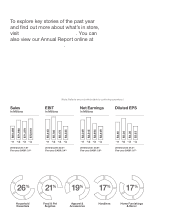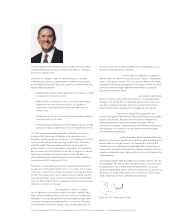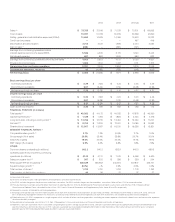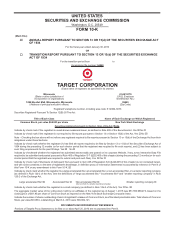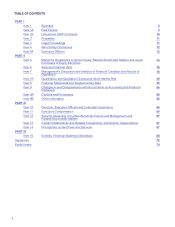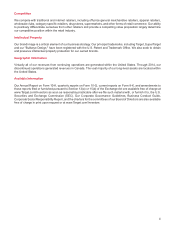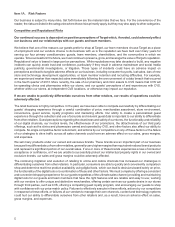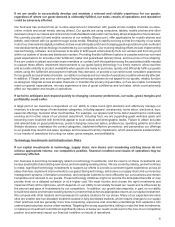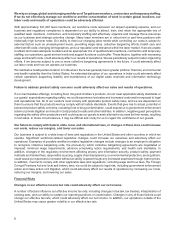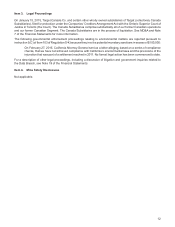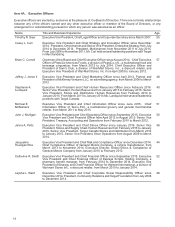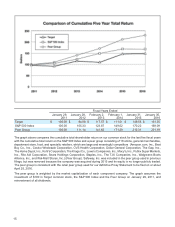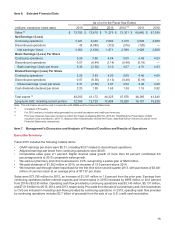Target 2015 Annual Report Download - page 11
Download and view the complete annual report
Please find page 11 of the 2015 Target annual report below. You can navigate through the pages in the report by either clicking on the pages listed below, or by using the keyword search tool below to find specific information within the annual report.
If we are unable to successfully develop and maintain a relevant and reliable experience for our guests,
regardless of where our guest demand is ultimately fulfilled, our sales, results of operations and reputation
could be adversely affected.
Our business has evolved from an in-store experience to interaction with guests across multiple channels (in-store,
online, mobile and social media, among others). Our guests are using computers, tablets, mobile phones and other
devices to shop in our stores and online and provide feedback and public commentary about all aspects of our business.
We currently provide full and mobile versions of our website (Target.com), offer applications for mobile phones and
tablets, and interact with our guests through social media. Retailing is rapidly evolving so that the majority of our sales
in all of our channels are digitally enabled, and we must anticipate and meet changing guest expectations and counteract
new developments and technology investments by our competitors. Our evolving retailing efforts include implementing
new technology, software and processes to be able to fulfill guest orders directly from our vendors and from any point
within our system of stores and distribution centers. Providing flexible fulfillment options is complex and may not meet
guest expectations for accurate order fulfillment, faster and guaranteed delivery times, and low-price or free shipping.
If we are unable to attract and retain team members or contract with third parties having the specialized skills needed
to support these efforts, implement improvements to our guest‑facing technology in a timely manner, allow real-time
and accurate visibility to product availability when guests are ready to purchase, quickly and efficiently fulfill our guests
orders using the fulfillment and payment methods they demand, or provide a convenient and consistent experience
for our guests across all sales channels, our ability to compete and our results of operations could be adversely affected.
In addition, if Target.com and our other guest‑facing technology systems do not appeal to our guests, reliably function
as designed, integrate across all sales channels, or maintain the privacy of guest data, or if we are unable consistently
meet our guests' expectations, we may experience a loss of guest confidence and lost sales, which could adversely
affect our reputation and results of operations.
If we fail to anticipate and respond quickly to changing consumer preferences, our sales, gross margins and
profitability could suffer.
A large part of our business is dependent on our ability to make trend‑right decisions and effectively manage our
inventory in a broad range of merchandise categories, including apparel, accessories, home décor, electronics, toys,
seasonal offerings, food and other merchandise. For example, our apparel and home décor assortment is continually
evolving and in other areas of our product assortment, including food, we are supporting guest wellness goals and
becoming more localized with items that appeal to local cultural and demographic tastes. Failure to obtain accurate
and relevant data on guest preferences, predict changing consumer tastes, preferences, spending patterns and other
lifestyle decisions, emphasize the correct categories, implement effective promotions, and personalize our offerings
to our guests may result in lost sales, spoilage, and increased inventory markdowns, which would lead to a deterioration
in our results of operations by hurting our sales, gross margins, and profitability.
Technology Investments and Infrastructure Risks
If our capital investments in technology, supply chain, new stores and remodeling existing stores do not
achieve appropriate returns, our competitive position, financial condition and results of operations may be
adversely affected.
Our business is becoming increasingly reliant on technology investments, and the returns on these investments can
be less predictable than building new stores and remodeling existing stores. We are currently making, and will continue
to make, significant technology investments to support our efforts to provide a consistent guest experience across all
sales channels, implement improvements to our guest‑facing technology, and evolve our supply chain and our inventory
management systems, information processes, and computer systems to more efficiently run our business and remain
competitive and relevant to our guests. These technology initiatives might not provide the anticipated benefits or may
provide them on a delayed schedule or at a higher cost. We must monitor and choose the right investments and
implement them at the right pace, which depends on our ability to accurately forecast our needs and is influenced by
the amount and pace of investments by our competitors. In addition, our growth also depends, in part, on our ability
to build new stores and remodel existing stores in a manner that achieves appropriate returns on our capital investment.
We compete with other retailers and businesses for suitable locations for our stores. Many of our expected new store
sites are smaller and non-standard footprints located in fully developed markets, which require changes to our supply
chain practices and are generally more time-consuming, expensive and uncertain undertakings than expansion into
undeveloped suburban and ex-urban markets. Targeting the wrong opportunities, failing to make the best investments,
or making an investment commitment significantly above or below our needs could result in the loss of our competitive
position and adversely impact our financial condition or results of operations.
6


